
16 minute read
Fish Identification Guide
Fish illustrations by Joseph R. Tomelleri



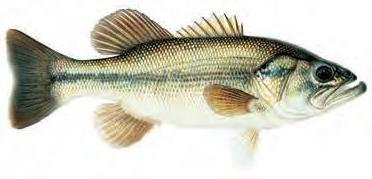
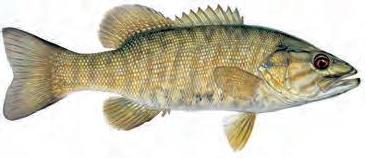

STRIPED BASS
The striped bass, or striper, is a saltwater native that has adapted to fresh water. Populations are maintained through stocking from fish produced at the Milford Fish Hatchery. Stripers have slender bodies: measurement from belly to back is generally less than one-third their length. They have distinct unbroken horizontal stripes.It is common for them to reach and exceed 20 pounds. Their spiny and soft dorsal fins are not connected; both fins do not pop-up when the spiny dorsal is manually erected. The back of the tongue has TWO tooth patches. Striped bass are temperature sensitive and fishing is usually best in winter, spring, and early summer.
WIPER
Wipers are a hybrid of white bass and striped bass, and they grow fast and fight hard. Populations are maintained through stocking. Small wipers look like white bass. They are deep-bodied: measurement from belly to back is generally more than one-third their length. They have distinct broken horizontal stripes. They may exceed 10 pounds. Spiny and soft dorsal fins are not connected; both fins do not pop-up when the spiny dorsal is manually erected. The back of the tongue has TWO tooth patches. Casting jigs, spoons or topwater plugs in spring and early summer is the most exciting way to catch them.
WHITE BASS
Native to eastern Kansas rivers, white bass have been stocked in reservoirs throughout the state. White bass are deep-bodied: measurement from belly to back is generally more than one-third their length. They generally do not have distinct horizontal stripes. They seldom exceed 3 pounds. Spiny and soft dorsal fins are not connected; both fins do not pop-up when spiny dorsal is manually erected. Back of tongue has ONE tooth patch. The spring spawning run is a great time to catch white bass in rivers and streams above reservoirs.
WHITE PERCH
White perch are an invasive species and it is illegal to possess them alive. However, many anglers fish for them and enjoy eating their white, delicious meat. It’s important for anglers to be able to tell them apart from white bass. White perch do not have a central tooth patch on their tongue and they do not have defined horizontal lines like white bass. Notice, too, that the spiny dorsal and soft dorsal fins are connected.
LARGEMOUTH BASS
The largemouth bass is native to many streams in eastern Kansas and has been stocked in most reservoirs, lakes, and ponds throughout the state. Largemouths are usually found near aquatic vegetation or other structure. The largemouth’s upper jaw extends beyond the eye. April and May are the best months to fish for largemouths. Best lures include spinnerbaits, jig-and-pig combinations, plastic worms, and crankbaits.
SMALLMOUTH BASS
Smallmouth bass are native to just a few streams in southeastern Kansas, but they have been stocked in several lakes and reservoirs. Smallmouths prefer clear water around rip-rap and rocky points. Brown to olive-green markings and an upper jaw that does not extend beyond the eye distinguish the smallmouth. The best months to catch smallmouths include April, May, and June. Best baits include curly-tail jigs, tube jigs, spinner baits, and crankbaits.
SPOTTED BASS
Spotted bass, or Kentucky bass, are native to the clear streams of the Flint Hills. They have been stocked in several reservoirs and lakes. The upper jaw does not extend beyond the eye, and they have distinct dark-green, diamond-shaped blotches along the upper half of the body. They also may have rows of dark spots along the lower belly. Small jigs, spinners, crankbaits, wooly worms, wooly buggers, and poppers are best baits.
Fish illustrations by Joseph R. Tomelleri

FLATHEAD CATFISH
Native to most of the state’s rivers, the flathead has adapted well to reservoirs. Flatheads are mottled brown/black to pale yellow in color. They have a broad flat head which has a lower jaw that extends beyond the upper jaw. Flatheads are generally much larger than channel cats, with weights of over 100 pounds reported. The anal fin has less than 30 supporting rays with round edges and the tail is a square and non-forked. Banklines, rod and reel, and trotlines are all popular methods, using live bait.
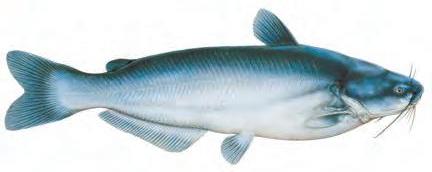
BLUE CATFISH
The blue catfish is native to rivers in northeast Kansas and has been stocked in select Kansas reservoirs, where it has flourished. Blues are pale blue in color although white or dark blue and black are not uncommon. The head generally appears small with a distinct hump in younger fish. The lower jaw is even with the upper jaw and weights of over 100 pounds have been reported. The anal fin is long, containing 30 or more supporting rays with a flat edge and the tail is forked. Blues are usually caught with cut or dead bait.






CHANNEL CATFISH
Channel catfish are native to Kansas and each year millions are stocked in community, state, and urban fishing lakes. They are often brownish-yellow in color with a white belly. Juveniles will have black or brown spots (See inset illustration) and spawning males can be dark blue in color. The lower jaw is even with the upper jaw and weights rarely exceed 30 pounds. The channel’s anal fin is shorter than the blue’s, with less than 30 supporting rays and a round edge. The tail is forked. Reservoirs, streams, state fishing lakes and ponds all provide excellent channel catfish angling opportunities. They can be caught using bank lines, trot lines and rod and reel, using dead or prepared bait –the smellier the better.
BULLHEAD
There are three species of bullheads in Kansas: the black, yellow, and brown. The black bullhead is common to streams and ponds, and the less common yellow is found mostly in the eastern half of the state. The bullhead is dark-green or yellow-green with a white or yellowish belly. The black bullhead is usually larger than the yellow and the barbels on the lower jaw are darker than the surrounding skin. The yellow’s barbels on the lower jaw are white. Bullheads exceeding 2 pounds are uncommon. Bullheads are great fish for young anglers, biting readily on worms, liver and dead bait.
BLUEGILL
Bluegill are native to eastern Kansas streams and have been stocked in ponds and lakes throughout the state. A saucer-shaped sunfish with a namesake blue tab on its gill cover, the bluegill is a popular sportfish that readily takes bait or small lures. It is a fine eating fish as well. Early June, when they move into the shallows and dish out small nests for spawning, is a great time to catch them. Fly gear is particularly effective at this time.
GREEN SUNFISH
The green sunfish is one of the most abundant sunfish in Kansas. It has the blue tab on its gill cover, but is somewhat less saucer shaped than the bluegill and has a noticeably larger mouth. Fins are usually edged in yellow. The green sunfish, or “greenie,” is a great fish for kids and will nearly always hit small baits and lures.


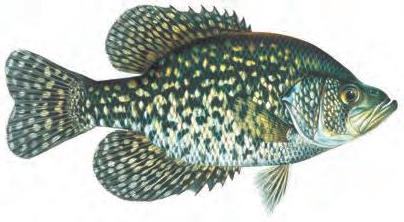



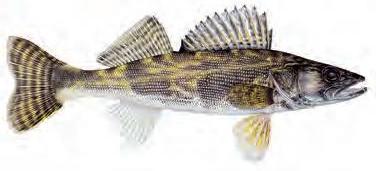
REDEAR SUNFISH
Fish illustrations by Joseph R. Tomelleri
The redear sunfish is an introduced species, stocked in small lakes and farm ponds. It is similar in shape to the bluegill and has a red trim around the tab on its gill cover. Redears get bigger than bluegill and are generally more difficult to catch. Called shellcrackers in the South, redears will feed on snails and other mollusks. Redears generally prefer deeper water than other sunfishes and are not usually found near shorelines.
BLACK CRAPPIE
The non-native black crappie has been stocked in reservoirs, and especially in smaller lakes and ponds. Black crappie have a dark green, uniform speckled coloration with no vertical barring. There are seven or eight spines in the dorsal fin. Black crappie prefer clear lakes or ponds and are not as prone to overpopulating as white crappie. April and May are best months to catch black crappie, and jigs, minnows, and small spinners are best baits.
WHITE CRAPPIE
The native white crappie is one of the most abundant and popular sportfish in Kansas. Vertical barring evident in the speckled coloration on white crappie distinguish them from black crappie. White crappie have six spines in the spiny dorsal fin, while black crappie have seven or eight. White crappie are generally found in large schools. April and May are the best months to catch white crappie, and best baits include minnows, jigs and small spinners.
PADDLEFISH
The unusual paddlefish is found in a few of the larger rivers of eastern Kansas, common only in the spring when they move upstream to spawn. They feed on plankton, and the only way to catch them is snagging. A special snagging season has been established on a few streams during the spring migration. Anglers use heavy tackle and hooks tied specifically for snagging. Paddlefish are long and thick bodied. They are blue in color with white bellies. They have a long snout, which readily identifies the fish from other species. Weights of over 100 pounds have been reported but 30 to 50 are more common.
WALLEYE
Stocked in many Kansas reservoirs, the walleye is a member of the perch family. The walleye is thick-bodied and brown/black and yellow in color with indistinct blotches on the sides, not extending below the lateral line. The spiny dorsal fin has indistinct streaks or blotches with a distinct dark blotch at its rear base. The cheekplate is smooth with few scales. April, May and early June are the best months to catch them. Anglers troll crankbaits or drift jigs with live bait to catch these fish.
SAUGER
Sauger are common in the Missouri River, and some may be found in the Kansas River. They have been stocked in several northeast Kansas reservoirs. The sauger is thinbodied and brown/black and yellow in color, with distinct blotches on the sides extending below the lateral line. The spiny dorsal fin is colorless with distinct circular black spots throughout. Their cheekplates are rough with scales. Drifting jigs or spinner rigs tipped with bait over main-lake points and mudflats is a popular angling technique with these fish.
SAUGEYE
The saugeye is a hybrid of a sauger and walleye and was first stocked in Kansas in 1990. Like other hybrids, the saugeye is hardy and grows fast.The saugeye is thickbodied and brown/black and yellow in color, with distinct blotches on the sides extending below the lateral line. The spiny dorsal has distinct streaks, often with one or two rows of spots at the base along with a dark blotch at the rear base of the fin. It’s cheekplate is rough with scales. Saugeye are often caught drifting flats and mainlake points with jig-night crawler combinations and trolling crankbaits.
Fish illustrations by Joseph R. Tomelleri

NORTHERN PIKE
The northern pike is a rare introduced species. It was stocked in the late 1960s as a means of controlling panfish. However, few Kansas waters provide the northern with suitable habitat. The northern pike prefers clear, weedy water. They are long and thick bodied. Occasionally, smaller lakes are stocked with northern pike to help control populations of undesirable fish, as well as provide anglers with an exciting opportunity.






BIGMOUTH BUFFALO
The bigmouth buffalo is native to the larger rivers of eastern Kansas, and has become abundant in many reservoirs. The buffalo feeds on plankton and is considered a nonsport fish. With an angled sucker mouth, the buffalo doesn’t feed on the bottom. At one time, it was an important commercial fish, and is still taken by commercial netters for fish markets. The buffalo prefers deep, still pools and can become quite numerous in oxbows and reservoirs.
COMMON CARP
The common carp was brought to the U.S. from Asia in the late 19th century. Originally stocked for a sportfish, the adaptable carp was soon considered a nuisance. Carp are common in nearly all waters in Kansas. They feed mostly on invertebrates and green plant material. Anglers use dough baits or corn to catch carp, and they fight hard. Intermuscular bones require special meat preparation, but it has many fans who have learned to prepare it.
DRUM
The drum is common in eastern Kansas rivers and streams and has adapted well to reservoirs. Also called sheepshead, the drum emits a grunting, or drumming, noise with special muscles that vibrate against the swim bladder. Jigs, jigs tipped with night crawlers, and crankbaits will catch drum, although a gob of worms stillfished might be the best technique. Although defined as a nonsport fish, their meat is white and tasty.
GRASS CARP
The grass carp is an introduced species brought from Asia. The grass carp’s diet is entirely vegetation, and it has been stocked to control aquatic vegetation. Only nonfertile, or triploid, grass carp may be stocked. Grass carp get big and are extremely powerful swimmers. Anglers have discovered they can be caught on small flies imitating bits of vegetation, and hooking a large grass carp can be a wild experience. Considered a nonsport fish, grass carp are legal bowfishing quarry.
RAINBOW/BROWN TROUT
Trout provide a winter fishery where they are stocked. Populations are maintained through winter stocking, and generally most of the stocked fish are caught during the Nov. 1 –April 15 season. However, the Mined Land Unit #30 in Cherokee County provides year-round trout fishing. Anglers are required to have a trout stamp in addition to the required licenses. A variety of methods are popular, from fly tackle or spinners to worms and PowerBait fished on the bottom.


LONGNOSE GAR
Fish illustrations by Joseph R. Tomelleri
The longnose gar is native to most of the rivers in the eastern half of Kansas and is the most abundant and largest of the three gar species. It is greenish in color with dark spots on its sides and fins and can be distinguished by its long, narrow snout, which is more than twice as long as the distance between the edge of the eye and the back of the head. The bony mouth makes it almost impossible to hook, so anglers use spinners with nylon thread instead of hooks. The nylon tangles in the fine teeth that line the jaws.
SHORTNOSE GAR
The shortnose gar has jaws less than twice the length of its head and has spots on its fins but differs from the spotted gar by the absence of spots on its head. The shortnose gar is common only in the larger rivers of eastern Kansas. Most shortnose gar are less than 24 inches long.

SPOTTED GAR
The spotted gar has jaws less than twice the length of its head and is spotted with dark, round spots on the top and sides of its head. Most spotted gar are less than 30 inches long. Like other gars, it is covered with a tough armor of thick, heavy scales. It may be confined to the lower Neosho basin where it prefers still pools.

Base of barbels form crescent line SOME pallids have colored scientific markers injected into bottom side of rostrum (snout) Four subtle lobes lower lip
A B Length of A greater than B Skin-like scaleless belly

Base of barbels form straight line Four distinct lobes lower lip
A B Length of A similar to B Thin scale-like plates on belly

Base of barbels form straight line Two distinct lobes lower lip
A B Length of A similar to B Skin-like scaleless belly
PALLID STURGEON
Pallid sturgeon are native to the Missouri and Mississippi River drainages and are present in the Kansas River. The largest one documented in Kansas was over 40 inches long. It is listed as an endangered species in Kansas and can be distinguished from the more common shovelnose sturgeon in that the four fringed barbels are not in a straight line across the snout, and the belly is usually scaleless. The dorsal fin has 3743 rays and the anal fin has 24-28 rays. Young pallid sturgeon that are stocked into the Missouri River may have florescent-colored tags on the underside of the snout. If you catch a sturgeon that is larger than 30 inches or weighs more than 5 pounds, it is likely a pallid sturgeon and must be released immediately.
SHOVELNOSE STURGEON
The shovelnose sturgeon is common in the Missouri, Kansas and Republican rivers and in lower parts of the Blue and Smoky Hill rivers. There is also a single record from the Arkansas River in Sedgwick County. Adults are usually 20-25 inches long. Often caught by anglers fishing with worms, the shovelnose can be distinguished from the endangered pallid in that the belly has small bony scales, and the four fringed barbels beneath the snout are in a straight line. The dorsal fin has 30-36 rays and the anal fin has 18-23 rays.
LAKE STURGEON
The lake sturgeon may be found in the Missouri and Kansas rivers in Kansas. The largest documented lake sturgeon was caught in Atchison County on the Missouri River and weighed 12.5 pounds and was 40 inches long. It is considered endangered in Kansas and can be distinguished from the other Kansas sturgeon by its short, bluntly-shaped snout that is not upturned. It's overall body shape is blunter than the other two sturgeon, as well, with a shorter tail and tail fin. The pectoral fins just behind the gills are smaller in comparison to body size than the other Kansas sturgeons.








